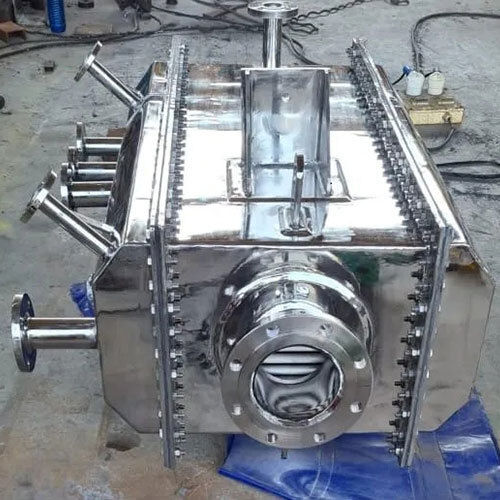Box Type Heat Exchanger Square Condenser
600000 INR/Unit
Product Details:
X
Box Type Heat Exchanger Square Condenser Price And Quantity
- 600000 INR/Unit
- 10 Unit
Box Type Heat Exchanger Square Condenser Trade Information
- hajira,porbandar
- Cash Advance (CA)
- 100 Unit Per Month
- 10 Days
- as per box
- All India
Product Description
A boxtype heat exchanger also known as a square condenser is a specific configuration of a heat exchanger used in various industrial processes for transferring heat between two fluids Heres an overview of its design function and applications
Design and Construction
1 Structure A boxtype heat exchanger typically consists of a series of square or rectangularshaped compartments or channels These channels are designed to allow the flow of two fluids in a counterflow or parallel flow arrangement
2 Materials They are constructed from materials such as stainless steel carbon steel copper or aluminum chosen based on the fluids being processed and environmental conditions
3 Internal Configuration Inside the boxtype heat exchanger the two fluids flow in separate channels or compartments One fluid often a hot fluid flows through one set of channels while the other fluid typically a cooler fluid flows through the remaining channels in a counterflow or parallel flow pattern
Function and Operation
1 Heat Transfer The primary function of a boxtype heat exchanger is to transfer heat from one fluid to another Heat is exchanged through the walls of the channels promoting efficient heat transfer between the two fluids without them mixing
2 Cooling or Condensing In the context of a square condenser the heat exchanger is specifically used for condensing a vapor into a liquid by transferring heat to a cooling medium typically air or water
3 Efficiency Boxtype heat exchangers are designed to maximize heat transfer efficiency by optimizing the surface area available for heat exchange and minimizing resistance to fluid flow
Applications
1 Refrigeration and Air Conditioning Used in HVAC systems for condensing refrigerants from vapor to liquid state facilitating cooling
2 Chemical Processing Employed in chemical plants for condensing vapors during chemical reactions or distillation processes
3 Power Generation Used in power plants for condensing steam in turbine exhaust systems to improve efficiency
4 Food and Beverage Industry Applied in food processing for cooling or condensing substances such as beverages or dairy products
Advantages
1 Compact Design Boxtype heat exchangers are often more compact than traditional shellandtube heat exchangers making them suitable for installations where space is limited
2 Efficient Heat Transfer They offer efficient heat transfer due to their optimized design which enhances the surface area available for heat exchange
3 Flexibility Can be adapted to various industrial applications and can handle a wide range of fluid types and temperatures
Considerations
1 Maintenance Regular cleaning and maintenance are essential to prevent fouling and ensure optimal heat transfer efficiency
2 Corrosion Resistance Selection of materials resistant to corrosion is crucial especially when handling aggressive fluids or operating in harsh environments
3 Pressure and Temperature Limits Operating conditions such as pressure and temperature should be within the design limits of the heat exchanger to ensure safe and efficient operation
Conclusion
A boxtype heat exchanger particularly when configured as a square condenser plays a critical role in industrial processes by efficiently transferring heat between fluids facilitating cooling or condensing operations Its design and construction are tailored to optimize heat exchange efficiency while meeting specific operational requirements across various industries
Tell us about your requirement

Price:
Quantity
Select Unit
- 50
- 100
- 200
- 250
- 500
- 1000+
Additional detail
Mobile number
Email



